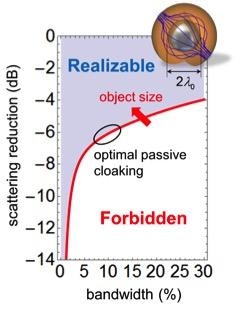Jul 7 2016
Researchers at the Cockrell School of Engineering at The University of Texas have successfully quantified the basic physical constrains of cloaking systems. Cloaking systems are devices that are used to conceal objects from electromagnetic waves such as microwaves, visible light, infrared and radio waves, by making them undetectable or invisible.
 The graph shows the trade-off between how much an object can be made transparent (scattering reduction; vertical axis) and the color span (bandwidth; horizontal axis) over which this phenomenon can be achieved. (Credit: Cockrell School of Engineering)
The graph shows the trade-off between how much an object can be made transparent (scattering reduction; vertical axis) and the color span (bandwidth; horizontal axis) over which this phenomenon can be achieved. (Credit: Cockrell School of Engineering)
The researchers theory confirms the possibility of using cloaks to hide an object completely for a specific wavelength, but hiding an object from an illumination containing different wavelengths is a bigger challenge as the size of the object increases.
Electrical and computer engineering professor, Andrea Alù, who is also an expert in the field of cloaking technology collaborated with graduate student Francesco Monticone, to develop a quantitative framework that can set limits on the bandwidth potential of electromagnetic cloaks for objects of various compositions and sizes. Due to this development, researchers can now create and develop customized cloaks for objects after estimating the maximum potential of invisibility systems. The duo’s work has been published in the journal Optica.
Metamaterials are used to produce these cloaks. These materials possess unique characteristics that allow them to make an object transparent or invisible and also provide them with better control over incoming waves. The limits set by Alù and Monticone are for cloaks that are made of passive metamaterials, which do not make use of external sources for energy.
Alù states that a better understanding of the size and bandwidth constrains is essential for estimating the capabilities of cloaking systems used in applications like biomedical systems, military radars and communication antennas. The framework developed by the duo indicates that the size of the object that has to be concealed and the incoming wave’s wavelength have a huge impact on the working of a passive cloak. It also shows that the cloaking becomes harder as the wavelengths become short.
Cloaking a moderate sized antenna from radio waves, to ensure better communications, over broad wavelengths is possible. However, concealing larger objects such as military tanks or human beings from visible light, which has shorter wavelengths when compared to radio waves, is an impossible feat to achieve.
We have shown that it will not be possible to drastically suppress the light scattering of a tank or an airplane for visible frequencies with currently available techniques based on passive materials, but for objects comparable in size to the wavelength that excites them (a typical radio-wave antenna, for example, or the tip of some optical microscopy tools), the derived bounds show that you can do something useful, the restrictions become looser, and we can quantify them.
Francesco Monticone, Graduate Student, University of Texas
The framework created by the researchers can act as a guide for any further study that is to be done on cloaking. Moreover, it can also help in eliminating some of the myths related to the cloaking and its capability to conceal objects completely by turning them invisible.
“The question is, ‘Can we make a passive cloak that makes human-scale objects invisible?’” Alù said. “It turns out that there are stringent constraints in coating an object with a passive material and making it look as if the object were not there, for an arbitrary incoming wave and observation point.”
With bandwidth boundaries available, developing new devices with the technology that are within the limits mentioned in the framework is possible.
If we want to go beyond the performance of passive cloaks, there are other options. Our group and others have been exploring active and nonlinear cloaking techniques, for which these limits do not apply. Alternatively, we can aim for looser forms of invisibility, as in cloaking devices that introduce phase delays as light is transmitted through, camouflaging techniques, or other optical tricks that give the impression of transparency, without actually reducing the overall scattering of light.
Francesco Monticone, Graduate Student, University of Texas
In order to attain broader transparency bandwidths in cloaks, Alù’s lab is using metamaterials that can draw energy from external sources.
“Even with active cloaks, Einstein’s theory of relativity fundamentally limits the ultimate performance for invisibility,” Alù said. “Yet, with new concepts and designs, such as active and nonlinear metamaterials, it is possible to move forward in the quest for transparency and invisibility.”